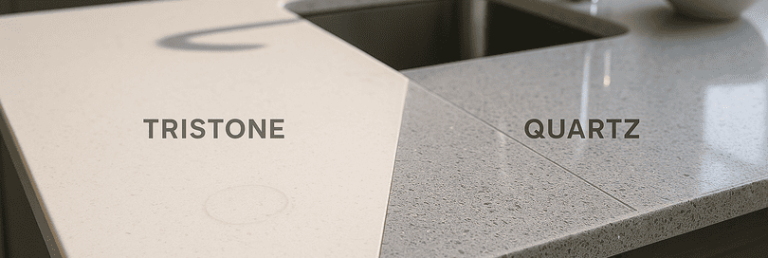Choosing a new worktop is both a style decision and a practical one. If you are deciding between Tristone and quartz as a worktop material, the right option depends on how you cook, clean, and use your space each day, as well as the look you want to achieve. Premium Worktops supplies and installs both categories, with an in-house factory, well-known brands, and pricing positioned well below typical high street rates. Should I choose Tristone or Quartz worktops?
Quick Answer
If you want warm-to-the-touch surfaces, seamless shaping, and design freedom for curves, coved upstands, and integrated sinks, Tristone is the flexible choice.
If you want a tough stone look with consistent patterning, low maintenance care, and strong everyday resistance to spills, quartz is a natural fit for solid worktops.
Understanding Tristone and Quartz Worktops
Tristone is a solid surface made from minerals and acrylic. It is non-porous, warm underhand, and can be thermoformed, which allows seamless runs, integrated bowls, and coved corners that reduce dirt traps. Joints are seamless and designed to be inconspicuous rather than truly invisible, which keeps the finish clean while staying true to how solid surfaces are fabricated.
Quartz is an engineered stone that blends natural quartz with resin to deliver dense, uniform slabs that suit kitchens and bathrooms. It is non-porous, durable, and low-maintenance. Premium Worktops carries leading ranges including Caesarstone, Silestone, Classic Quartz, Compac, Fugenstone, and Bloom Stones, and offers free samples so you can see colours in your own light.
Understanding these distinctions will help you decide if functionality, finish, or design freedom matters most for your space. Our team at Premium Worktops Direct is always happy to share samples, answer questions, and help you move from inspiration to installation. Wondering “should I choose Tristone or Quartz worktops?”, let’s connect to discover the perfect fit for your next project.
Design Freedom and Finishes
Tristone for seamless creativity
Thermoforming enables soft curves and flowing islands. Coved upstands and integrated sinks are possible, and the finish can be refinished if light marks appear. For upstands, Premium Worktops offers coved options that blend into the worktop or square versions, typically 50 to 75 millimetres in height.
Quartz for consistent elegance
Because quartz is produced as uniform slabs, colour and veining stay consistent across joins. Standard edge details for stone include bevel as the default, with other profiles available on request. Typical slab sizes range from about 2800 by 1800 millimetres to 3200 by 1600 millimetres, which helps with planning long runs and islands.
Performance in Daily Use
Heat and stain response
Both materials cope with day-to-day heat and are non-porous, which means everyday spills wipe away easily from countertops. Use a trivet for very hot pans or trays to protect the surface. For quartz, Premium Worktops notes that warm soapy water is usually enough and that tougher marks can be lifted with a normal creamy cleaner. For acrylic solid surfaces, the same simple routine applies, with the added guidance to keep hot cookware off the surface.
Scratch and impact behaviour
Quartz is very hard, which helps resist scuffs from regular cooking activity. Tristone is durable and also repairable. Minor surface marks can often be refinished to restore a consistent sheen because the material is the same throughout its depth.
Hygiene
Non-porous construction means there are no open pores for liquids to soak into. With Tristone, seamless joins and the option for coved corners reduce places where residue collects. With quartz, tight, neat seams and a sealed, consistent surface, keep cleaning quickly.
Care and Maintenance
Daily care is straightforward.
- Wipe with warm, soapy water and a soft cloth.
- For stubborn marks on quartz, use a regular creamy cleaner as directed.
- Avoid harsh chemicals.
- Use chopping boards to prevent knife marks.
- Keep very hot pans on trivets or pan bars rather than directly on the surface.
These simple habits keep either worktop looking fresh for years and follow Premium Worktops’ recommendations.
Installation and Service from Premium Worktops
The team manages templating, fabrication, and fitting. After you approve a quotation, they schedule templating, ideally with two to three weeks’ notice. Once templated, the usual lead time to installation is seven to ten working days. Undermounted sinks are bonded to the new worktop during fitting, and plumbing or electrical work is handled by your chosen trades. Worktops include at least a ten-year manufacturer’s warranty, with brand warranties available for quartz ranges.
Tristone and Quartz Worktop: Pricing and Value
Exact pricing depends on your colour, thickness, edge detail, and layout. Because Premium Worktops operates its own factory, it can provide bespoke quartz worktops at prices positioned well below typical high street offers, and the acrylic ranges offer strong value for made-to-measure details such as curves and coved upstands. Ask for a transparent quotation to compare options side by side.
Which Worktop Material Should You Choose?
Use this simple checklist to compare acrylic worktops and quartz worktops.
- You want flowing curves, a coved upstand, or an integrated sinkChoose Tristone for seamless shaping and practical detailing.
- You want a uniform stone look with minimal day-to-day fuss
Choose quartz for hardness, consistency, and easy cleaning. - You prioritise hygiene and simple maintenance
Both are non-porous and wipe clean quickly. Tristone has the edge where fully continuous surfaces and coved corners matter to you.
Ready to Move Forward
Request a free same-day quote, ask for colour samples for your countertop, or book a design chat. If you already have plans and rough measurements, share them to speed up templating and confirm feasibility. Once templated, fitting usually follows within seven to ten working days, so you can plan your project with confidence.
